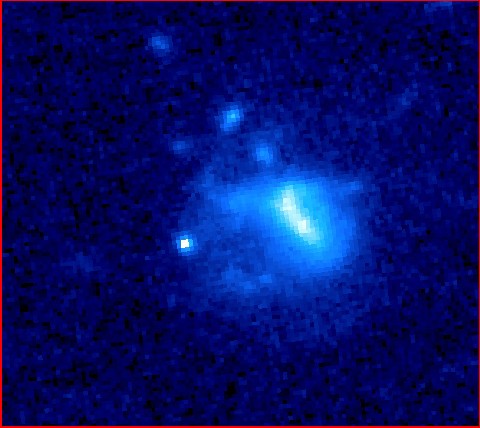
home •
about •
essential guide •
picture of the day •
thunderblogs •
news •
multimedia •
predictions •
products •
get involved •
contact
picture of the day archive subject index
Credit: Derek Fox/Penn State University
Aug 14, 2007
Gamma Ray BurstersGamma-ray bursts could indicate the merging of neutron stars—if the universe contained neutron stars instead of plasma. GRB's have a simple explanation in the Electric Universe Model.
A gamma-ray burst (GRB) is a flash of high-energy radiation that lasts up to a few seconds. GRBs appear randomly around the sky at a rate of about one a day. An afterglow in x-ray and optical light may follow the burst and fade over several days. Analysis of afterglows enabled astronomers to link GRBs with “host” galaxies and the longer-lasting bursts with supernovas. Until this year, afterglows following the shorter bursts had not been detected.
A burst that lasted a tenth of a second was detected on July 9, 2005. Thirty seconds later, a 150-second x-ray flash was observed, and the location of the burst could be pinpointed. A few days later, the Hubble Space Telescope obtained this image of the optical afterglow and the “host” galaxy. (The afterglow is the bright dot to the left of the extended image of the galaxy.)
According to conventional theories, the redshift of this galaxy determines its distance at about two billion light years. To appear as bright as it did, the GRB must have given off more energy in that one-tenth of a second than the entire galaxy gives off in a year. The only mechanisms imaginable in a gravity-dominated universe that could be this “energy-dense” are extreme supernovas and neutron-star or black-hole mergers. Because no supernova was observed and because the GRB occurred at the edge of the galaxy (most black holes are thought to reside in galactic cores), this GRB is considered to be the result of a merger of neutron stars.
This explanation makes sense—if redshift is indeed a measure of distance and if the universe is composed of insignificant amounts of plasma. Unfortunately, redshift has been shown for decades NOT to be a measure of distance, and the composition of the universe is 99.99% plasma.
This GRB and its “host” galaxy are closer, probably much closer, than standard theory calculates. The energy of the GRB is therefore much less than standard theory calculates. The small, faint “host” galaxy doesn’t appear small and faint because it’s far away but because it really is small and faint.
Even if it were at its conventional distance, and even if it did have its conventional energy, plasma mechanisms—that is, electrical discharge mechanisms—could provide the necessary density of energy with processes that can be studied in laboratory settings. (Black holes and neutron stars are exclusively manipulations of mathematics and have no empirical counterparts.)
The primary sources of information about GRBs are their spectra and their time histories. The spectra indicate emission of x-rays from highly excited ions and from fast electrons. The time histories vary greatly but generally show a fast rise of energy and a gradual fading. Sometimes one or more lower-energy pulses precede the peak energy pulse; often other spikes, which also show the fast-rise-slower-decline profile, interrupt the decline in energy.
Even with many factors that can be adjusted, conventional theory has a hard time matching a model to the observations. But the excited ions, fast electrons, and range of energy curves are common properties of lightning. They occur—at the appropriate energy levels—in lab discharges, atmospheric lightning, solar flares, supernovae, and, now, in GRBs. Experiments and computer simulations have shown that plasma phenomena can be scaled over many orders of magnitude—that is, they behave in much the same manner and obey the same principles from the atomic scale to the galactic.
A century of research in plasma and half a century of space exploration have demonstrated that we live in an electric universe. Only traditional astronomical theory is living in another universe—the universe of denial.
___________________________________________________________________________Please visit our Forum
The Electric Sky and The Electric Universe available now!

|
|

|
EXECUTIVE EDITORS:
David Talbott, Wallace Thornhill
MANAGING EDITORS:
Steve Smith, Mel Acheson
CONTRIBUTING EDITORS: Michael Armstrong, Dwardu Cardona,
Ev Cochrane,
C.J. Ransom, Don Scott, Rens van der Sluijs, Ian Tresman
WEBMASTER: Brian Talbott
Copyright 2007: thunderbolts.info
![]()
home •
thunderblogs •
forum •
picture of the day •
resources •
team •
updates •
contact us

